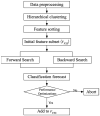A Novel Approach to Dual Feature Selection of Atrial Fibrillation Based on HC-MFS
- PMID: 38893671
- PMCID: PMC11171513
- DOI: 10.3390/diagnostics14111145
A Novel Approach to Dual Feature Selection of Atrial Fibrillation Based on HC-MFS
Abstract
This investigation sought to discern the risk factors for atrial fibrillation within Shanghai's Chongming District, analyzing data from 678 patients treated at a tertiary hospital in Chongming District, Shanghai, from 2020 to 2023, collecting information on season, C-reactive protein, hypertension, platelets, and other relevant indicators. The researchers introduced a novel dual feature-selection methodology, combining hierarchical clustering with Fisher scores (HC-MFS), to benchmark against four established methods. Through the training of five classification models on a designated dataset, the most effective model was chosen for method performance evaluation, with validation confirmed by test set scores. Impressively, the HC-MFS approach achieved the highest accuracy and the lowest root mean square error in the classification model, at 0.9118 and 0.2970, respectively. This provides a higher performance compared to existing methods, thanks to the combination and interaction of the two methods, which improves the quality of the feature subset. The research identified seasonal changes that were strongly associated with atrial fibrillation (pr = 0.31, FS = 0.11, and DCFS = 0.33, ranked first in terms of correlation); LDL cholesterol, total cholesterol, C-reactive protein, and platelet count, which are associated with inflammatory response and coronary heart disease, also indirectly contribute to atrial fibrillation and are risk factors for AF. Conclusively, this study advocates that machine-learning models can significantly aid clinicians in diagnosing individuals predisposed to atrial fibrillation, which shows a strong correlation with both pathological and climatic elements, especially seasonal variations, in the Chongming District.
Keywords: atrial fibrillation; clustering; feature selection; machine learning.
Conflict of interest statement
We, the authors of this manuscript titled “A novel Approach to Dual Feature Selection of AF Based on HC-MFS”, declare that we have no conflicts of interest that could potentially bias the results or interpretation of the research presented in this paper. A conflict of interest exists when an author’s financial, personal, or professional affiliations or relationships could influence their judgment, objectivity, or the integrity of the research. We affirm that there are no financial relationships or connections with any organization or individual that could be perceived as a conflict of interest regarding this work. Furthermore, we confirm that we have no personal relationships or conflicts of interest with any individuals, such as colleagues or competitors, that would impact our ability to conduct this research objectively and report the findings impartially.
Figures
Similar articles
-
Integrative transcriptomic, proteomic, and machine learning approach to identifying feature genes of atrial fibrillation using atrial samples from patients with valvular heart disease.BMC Cardiovasc Disord. 2021 Jan 28;21(1):52. doi: 10.1186/s12872-020-01819-0. BMC Cardiovasc Disord. 2021. PMID: 33509101 Free PMC article.
-
A filter approach for feature selection in classification: application to automatic atrial fibrillation detection in electrocardiogram recordings.BMC Med Inform Decis Mak. 2021 May 4;21(Suppl 4):130. doi: 10.1186/s12911-021-01427-8. BMC Med Inform Decis Mak. 2021. PMID: 33947379 Free PMC article.
-
Prediction model of atrial fibrillation recurrence after Cox-Maze IV procedure in patients with chronic valvular disease and atrial fibrillation based on machine learning algorithm.Zhong Nan Da Xue Xue Bao Yi Xue Ban. 2023 Jul 28;48(7):995-1007. doi: 10.11817/j.issn.1672-7347.2023.230018. Zhong Nan Da Xue Xue Bao Yi Xue Ban. 2023. PMID: 37724402 Free PMC article. Chinese, English.
-
Analysis of Relevant Features from Photoplethysmographic Signals for Atrial Fibrillation Classification.Int J Environ Res Public Health. 2020 Jan 13;17(2):498. doi: 10.3390/ijerph17020498. Int J Environ Res Public Health. 2020. PMID: 31941071 Free PMC article.
-
Risk of Stroke vs. Intracerebral Hemorrhage in Patients with Non-Valvular Atrial Fibrillation Undergoing Percutaneous Coronary Intervention: A Systematic Review and Meta-Analysis of Randomized Controlled Trials Comparing Dual vs. Triple Antithrombotic Therapy.J Stroke Cerebrovasc Dis. 2021 Apr;30(4):105654. doi: 10.1016/j.jstrokecerebrovasdis.2021.105654. Epub 2021 Feb 10. J Stroke Cerebrovasc Dis. 2021. PMID: 33578352
References
-
- Vos T., Lim S.S., Abbafati C., Abbas K.M., Abbasi M., Abbasifard M., Abbasi-Kangevari M., Abbastabar H., Abd-Allah F., Abdelalim A., et al. Global burden of 369 diseases and injuries in 204 countries and territories, 1990–2019: A systematic analysis for the Global Burden of Disease Study 2019. Lancet. 2020;396:1204–1222. doi: 10.1016/S0140-6736(20)30925-9. - DOI - PMC - PubMed
-
- Joseph P.G., Healey J.S., Raina P., Connolly S.J., Ibrahim Q., Gupta R., Avezum A., Dans A.L., Lopez-Jaramillo P., Yeates K., et al. Global variations in the prevalence, treatment, and impact of atrial fibrillation in a multinational cohort of 153 152 middle-aged individuals. Cardiovasc. Res. 2021;117:1523–1531. doi: 10.1093/cvr/cvaa241. - DOI - PubMed
-
- Chen Y., Gue Y., Calvert P., Gupta D., McDowell G., Azariah J.L., Namboodiri N., Bucci T., Jabir A., Tse H.F., et al. Predicting stroke in Asian patients with atrial fibrillation using machine learning: A report from the KERALA-AF registry, with external validation in the APHRS-AF registry. Curr. Probl. Cardiol. 2024;49:102456. doi: 10.1016/j.cpcardiol.2024.102456. - DOI - PubMed
-
- Al Snousy M.B., El-Deeb H.M., Badran K., Al Khlil I.A. Suite of decision tree-based classification algorithms on cancer gene expression data. Egypt. Inform. J. 2011;12:73–82. doi: 10.1016/j.eij.2011.04.003. - DOI
Grants and funding
- GWVI-11.1-49/Three-Year Action Plan 300 for Strengthening the Construction of Public Health System in Shanghai (2023-2025) of Key disci- 301 pline construction project
- 22MC2022001/Shanghai University of Medicine & Health Sciences Lo- 299 cal High-level University Construction Project
- GWVI-6/Three-Year Action Program of Shanghai Municipality for Strengthening the Construction of Public Health System
LinkOut - more resources
Full Text Sources
Research Materials



